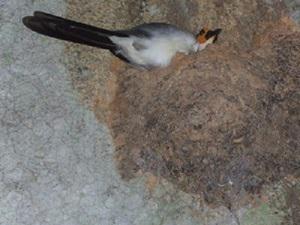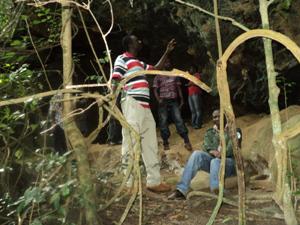Evelyn Asante-Yeboah
The aim of the project is to improve the understanding of the drivers of the species decline and provision of distributional and abundance data for conservation planning.

Rockfowl in its nest.
Drastic declines of the upper Guinean endemic White-necked Rockfowl (Picathartes gymnocephalus) have aroused considerable conservation concerns. Unfortunately, existing conservation interventions are hindered by a coherent understanding of drivers of the species’ declines, and a pervasive paucity of its distribution and abundance patterns.

A section fo the group under a rock (nest) with the PI taking GPS coordinate.
This project represents the first integrated project linking research with conservation action. Ongoing conservation initiatives pertaining to the White-necked Rockfowl in Ghana focus on investigation on the ecological and biological behaviour of the species in its habitat. This project is designed to fill important information gaps regarding causes of the species decline and contribute to improved understanding of the species distribution and initiate some conservation action on the ground with local communities. This will be done by surveying and mapping the distribution of the species within its known range in the Brong Ahafo region of Ghana and produce up to date distribution map of the species. This map will show areas with occurrences of the species and can be used to guide future research and in development of ecotourism plans in the area. The maps will be invaluable in positioning nesting sites of the species as these are critical to the species survival and must be protected. Researchers and academic institutions can also use the map as reference point for other research in the area. Moreover, previous studies failed to document existing and potential threats associated with local use of the species’ habitat. The documentation of the potential and existing threats will produce a blue print for action by the Forestry Commission, academic institutions and researchers. It will also influence policy making and aid in conservation of the species.
A key outcome of the project will be the local support to be gained and solutions generated to save the species. Through conservation education and awareness creation, we expect that the project will catalyse behaviour change among local people and stop any intentional persecution of the species. It is expected that the local people will take special pride in this species and make efforts to protect it. These outcomes are believed to contribute to long lasting biodiversity conservation.